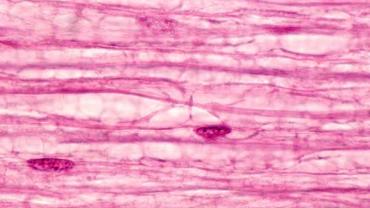
Research published last month in Nature Communications is being publicized as having potential to lead to “new therapies for nervous system disorders” and even for “rewriting the textbook on the peripheral nervous system.” The paper, “Myelinating Schwann cells ensheath multiple axons in the absence of E3 ligase component Fbxw7,” showed that myelin-producing Schwann cells are more plastic and prolific than was previously known—a finding that may have implications for developing new therapies for multiple sclerosis, Charcot-Marie Tooth disease and other neuropathies and nervous system pathologies.
It is understood that oligodendrocytes in the brain and spinal cord generate myelin for multiple axons. Schwann cells, on the other hand—myelin-producing cells in the peripheral nervous system (PNS)—were believed to synthesize myelin for just one axon. However, the new research shows that Schwann cells (SCs) are indeed capable of myelinating multiple axons, a finding that senior study author Kelly Monk, PhD, said, “totally overturns the textbook definition of the way Schwann cells work.”
The research was inspired by findings in zebrafish with mutations in the gene fbxw7. According to a press release from Oregon Health & Science University, where the research was conducted, “They discovered some fish had more myelin than expected, and those fish carried a mutation in a gene called fbxw7. When they knocked out the gene in genetically modified mice, they discovered an unexpected characteristic: individual Schwann cells began spreading myelin across many axons.”
In the experimental mice, loss of the fbxw7 gene dramatically increased the myelinating potential of SCs throughout the animals’ lives, with single SCs simultaneously myelinating as many as five axons. The researchers pointed out that the mutant SCs were myelinating multiple different axons, making it different from polyaxonal myelination, which they explained as a bundle of axons being myelinated together as if it were a single larger axon. Polyaxonal myelination has been documented in the past; what’s groundbreaking here is for SCs to myelinate multiple individual axons.
Researchers evaluated features of the unique, mutated SCs to ensure they were not oligodendrocytes that had migrated into peripheral nerves. Physiological and morphological characteristics of these cells proved that they were indeed SCs, and that the enhanced myelinating activity observed was not due to infiltration by oligodendrocytes. As explained in the paper, “…data suggest that SCs lacking Fbxw7 become multipolar and myelinate or interact with multiple axons simultaneously in a manner reminiscent of OL myelination.”
Not every SC showed this increased myelinating potential, however. This was observed in only about 12 percent of the fbxw7 mutant SCs. Still, if distinctions can be made between these cells and mutant SCs that do not have enhanced myelinating capacity, perhaps this can be harnessed to create SC lines exclusively for regenerating myelin in individuals with nerve injuries and various neuropathies. Study authors called for future research to explore exactly this—the implications of this enhanced myelination potential on remyelination and nerve repair after PNS injury.
While this finding likely does have potential for treating nervous system injuries, this is only the beginning of inquiry into this possibility, and it might not have quite the impact it may appear to have at first glance. With regard to multiple sclerosis (MS), for example, while this condition is typically thought to result from demyelination of axons in motor neurons, disability has been shown to correlate more strongly with axon destruction and degree of neuronal loss than with demyelination. Research on MS is beginning to move away from demyelination and toward cellular bioenergetics, with evidence indicating that the energetic capacity of neurons may play a bigger role in MS pathology than does loss of myelin. Degenerating axons have been shown to contain dysfunctional mitochondria, whereas axons that survive after demyelination contain highly functional mitochondria with increased activity of the electron transport chain, and thus, greater generation of ATP. With regard to MS, researchers have written, “It is thought that, where axons degenerate following demyelination, they do so when energy production by mitochondria becomes inadequate. Mitochondrial function seems to determine the fate of axons under duress.” In plain English, it may have more to do with neuronal energy than with myelin.
Another factor to consider in connection with neurodegenerative disorders and nervous system injuries is cholesterol. It’s time to stop demonizing cholesterol and start seeing it as a friend, rather than a foe to be eliminated without regard for its essential role in every cell of the body. Cholesterol is a major structural constituent of myelin, and in fact is “the only integral myelin component that is essential and rate limiting for the development of CNS and PNS myelin.” (Emphasis added.) In the mature mammalian brain, the highest cholesterol content is found in myelin.
Rather than avoiding egg yolks, butter, cheese and bacon, research suggests that higher intakes of dietary cholesterol may be beneficial for facilitating myelination. It was shown in mouse models of MS (experimental autoimmune encephalomyelitis) that dietary cholesterol “directly facilitates oligodendrocyte differentiation, presumably by relieving cells from time and energy intensive cholesterol synthesis. Altogether, these effects provide a ‘fast track’ to remyelination and repair.” In fact, in experimental models of peripheral nerve injury, LDL receptor expression is increased, possibly for the purpose of importing more cholesterol to aid in axonal repair.
The new findings regarding mutant Schwann cells with enhanced myelinating capacity should give us more reason to reexamine old beliefs about cholesterol. Even if these cells are capable of synthesizing myelin for multiple axons, they still need the raw materials with which to do so, and an absolutely essential raw material for myelin is cholesterol.